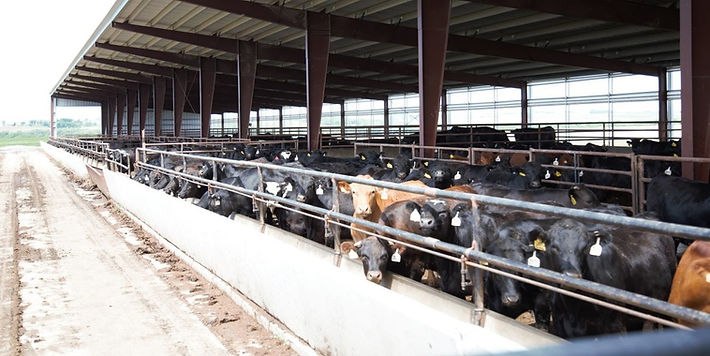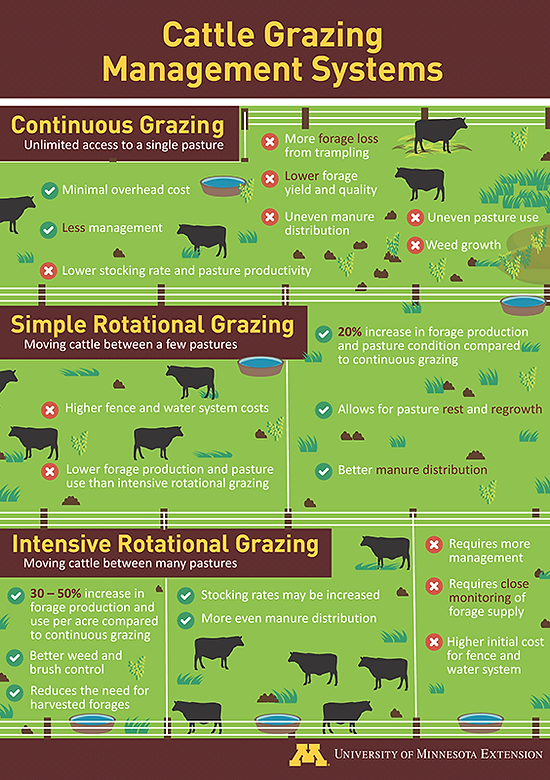
Beef Up Your Health
Grass-fed meat, especially beef, is one of the healthiest foods available to us, superior to grain-fed/finished, and more nutritious than any other protein you could consume. Responsibly raised beef through regenerative agriculture has the potential for economic and environmental gain as well as advancements in human, environmental, and animal health.
Red Meat and its Health Benefits
As you can see in the image to the right, red meat is packed with essential vitamins and nutrients. It is the most bioavailable form of protein, and the only one containing all 9 essential amino acids. Not only is it the highest quality protein, but the highest quality of fat too. Animal fats contain the correct ratio of omega-3s and omega-6s, optimal for preventing inflammation and optimal brain health. The consumption of red meat has been found to aid in some inflammatory disorders like autoimmune disease, skin conditions, even allergies. With most of our serotonin stored in our gut, it is no surprise meat consumption can boost energy, mental health, eradicate brain fog, and even help mental illness. Red meat is the only food that contains significant amounts of nutrients such as creatine, taurine, carnosine, heme iron, DHA, all imperative for healthy brain, muscle, and nervous system function. Red meat also contains branch chain amino acids or BCAAs, in which only they can be taken up by muscle tissue and oxidized for energy. The amino acid profile in red meat makes it optimal for muscle protein synthesis. Also, contrary to popular belief, meat is easier to digest than plants or plant-based proteins. Because animals literally have physical defense mechanisms such as claws and sharp teeth, they do not contain any irritating enzymes or anti-nutrients that plants and/or plant proteins contain in order to “protect themselves”. Red meat is among the top foods that is more easily digested by the GI tract with little to no nutrient waste, containing many different important enzymes, antibodies, and hormones all essential for optimal cellular function.


"Cows in a Feedlot" - Iowa Cattleman's Association https://www.google.com/url?sa=i&url=https%3A%2F%2Fwww.iacattlemen.org%2Fica-programs%2Fcustom-cattle-feeders%2Fwhat-is-custom-cattle-feeding&psig=AOvVaw2QHzQxdMCkpAMsKr99Wxyl&ust=1740419519453000&source=images&cd=vfe&opi=89978449&ved=0CBQQjRxqFwoTCNit65Ou2osDFQAAAAAdAAAAABAE
"'Rotational Grazing for Cattle" - The Seasonal Homestead https://www.google.com/url?sa=i&url=https%3A%2F%2Fwww.iacattlemen.org%2Fica-programs%2Fcustom-cattle-feeders%2Fwhat-is-custom-cattle-feeding&psig=AOvVaw2QHzQxdMCkpAMsKr99Wxyl&ust=1740419519453000&source=images&cd=vfe&opi=89978449&ved=0CBQQjRxqFwoTCNit65Ou2osDFQAAAAAdAAAAABAE
Grass Fed Vs Grain Fed and What Does That Even Mean?
It’s important to note that even if meat is labeled “grass-fed”, that can still mean they were fed grain to fatten them up to 6 months prior to their death. It is important to read labels and know what they mean/what you are buying. Grain-fed or finished cows will be fattier, but less nutritionally dense. Although meat is one of the healthiest foods for you, grain typically involves human-inedible forage, biofuel, food industry byproducts, not to mention grain contains things like mold, mycotoxins, soy, and corn which is sprayed in glyphosate, as well as xenoestrogens and other chemicals that will disrupt your endocrine system. This interview I found with former cattle rancher and author Michael Pollen actually delves into the modern day cattle system and its corruption, the true lifespan of a cow in America, the differences between a grain fed/finished diet vs. a grass fed/finished diet, how cows were not made to digest corn/ grain, how a grass-fed cow is best for our omega-6 to omega-3 ratio, use of antibiotics, rise of microbes, antigens, pathogens/importance of cleanliness. I highly recommend reading this interview, as it simplifies the cattle industry, calls out issues within the industry, and highlights the health benefits humans receive. Read the interview here.
To the left, you can see cows huddled together in a feedlot versus below it, where the cows left free to roam. The inferences that could be made about the health of the different cows are apparent just from these two pictures.
Responsibly, Regeneratively-grown Meat Has the Potential to Benefit Human, Animal, Pastural, and Environmental Health
To put the environmental aspect into perspective, the U.S. has a 10-50x lower carbon footprint from cattle as opposed to comparative cattle-producing countries, with only 2% of our total GHG emissions coming from cattle. Cows actually serve as up-cyclers, providing more human-edible protein than they consume. However, regenerative agriculture will yield the most environmental benefits. Regenerative farms practice rotational grazing. This allows animals to roam freely, meaning no grass is ever eaten all the way down to the ground, plants/roots stay intact, soil remains healthy, grass stays healthy, animals remains healthy, turning even the manure healthy. Nutrient-rich soil and grass draw carbon out of the atmosphere, creating a net-zero carbon effect, even sometimes a carbon-negative effect. The concept of grazing is more natural to animals, ensuring they’re their healthiest selves because the healthier the animal, the healthier their meat will be, the healthier we will be. The animals, the pastures, the environment, and humans all benefit from regenerative agriculture and rotational grazing. It’s easy, pasture raised and grass-finished = reduction in climate change. In fact, all of the nitrogen runoff coming from all the pesticides we spray on crops in the Midwest runs down the Mississippi and is further contributing to the pre-exisitng dead zones in the Gulf of Mexico thousands of miles wide. All for corn and soybeans to feed to cattle that cannot even properly digest it.

"Cattle Grazing Managment" - University of Minnestoa https://www.google.com/url?sa=i&url=https%3A%2F%2Fextension.umn.edu%2Fpasture-based-dairy%2Fgrazing-and-pasture-management-cattle&psig=AOvVaw2VSE_tLD0Ljcm15s-SKeAu&ust=1740420150446000&source=images&cd=vfe&opi=89978449&ved=0CBQQjRxqFwoTCMCQnbmw2osDFQAAAAAdAAAAABAE
One Might Say:
Two popular counterarguments and why they don't hold weight
"But what about my cholesterol?" - That's just bad science.
The first counterargument I hear is questioning possible negative health effects associated with red meat consumption like high cholesterol, CVD, cancer, etc. I deem this due to bad science. First off, it should be noted that the AHA demonized cholesterol in the late 60s and started a public smear campaign demonizing saturated fat and incorrectly pushing the narrative that too much meat/fat is bad for you and will clog your arteries. This is misleading, as saturated fats are vital for hormone production and the absorption of vitamins, minerals, nutrients, etc. The AHA manipulated the FDA with money and influence to change the dietary nutritional guidelines to center around carbs and grains instead of meat. Glucose from carbs create a blood sugar spike, making you hungrier, more inclined to eat more carbs, leading to an excess of insulin in the blood, leading to long term inflammation over time. More recent studies have shown that high-glycemic carbohydrates are to blame for chronic inflammation in the body and won't allow for proper disposal of excess cholesterol we may have. The flaws in past studies must be pointed out too. Several studies tying red meat to such diseases are epidemiological studies, which naturally are not very effective at proving cause and effect. Many studies were flawed or biased in nature and contained several confounding variables. For example, participants in one trial were just simply asked how many times per year they ate red meat, not asked to track, just asked to recall how many times meat has been consumed over the past year. These people also reported smoking, drinking, being sedentary, eating dairy, taking aspirin, and eating more calories consumed, so how can we be sure these adverse effects came from red meat consumption? Other studies are also flawed in the sense that they lumped together all kinds of meat. For example, a grass-fed ribeye is not built the same as a hot dog, sausage, or deli meat. Most of the time, processed meats contains carcinogens like nitrates, PAHs, HCAs or other preservatives that have already been linked to cancer so it is very important we have unbiased, randomized-controlled studies. Simply put, meat and its connection to cholesterol and negative health effects are just a result of cherry-picked science, misleading information, and fear-mongering all fueled by the food and pharmaceutical industry.
"But red meat is too expensive" - That's just a bad mindset.
The second counterargument I hear is that meat is too pricey to be consuming all the time. Although beef is the most economical protein gram for gram, it will still cost some money. Although quality cuts and quality beef may cost more, any meat is still better than packaged food or a synthetic protein. My rebuttal to this is to just buy it. Even if it is not grass-fed/finished ribeye, any meat or protein is better than nothing. Plenty of people spend their money on things like fast food, DoorDash, restaurants, etc. At the end of the day, if someone’s health is really their priority, their wallets will reflect it. If someone is buying a coffee every morning, buying new clothes every season, getting takeout multiple nights a week, it is no longer a money issue, it is a prioritization issue. The graph below demonstrates the little uptick in price of beef over the ocurse of a year.

Beef Cuts by Price - Raising the Steaks https://www.engage3.com/2024/01/raising-the-steaks-the-story-behind-rising-beef-prices/
Putting It All Together
The evidence of the positive impact red meat, especially when grass fed/finished, has on human health is insurmountable. We as individuals can see and feel these changes from making grass-fed beef a staple. The environment has much to benefit from regenerative agriculture, as well as the possible economic benefits. In doing so, the animals are treated more humanely, making them healthier and tastier. This in turn, will make society healthier, nourished, stronger, and happier. Although the public has demonized red meat and animal fat through misleading science and fearmongering about animal and environmental treatment, red meat remains one of the worlds top superfoods, and people are not eating enough of it. At the end of the day, whole foods, a good mindset, and correct science is essential for an overall betterment of personal health, and red meat is just one of those tools to be utilized.
Get to Know Me
My name is Miranda. I am a student at CSU, studying health science. For the past couple years, my interest in health and wellness has blossomed. In recent years, I think we as a society have all started to view our health differently along with the systems we have put in place to aid human health. I believe in more root cause, integrative medicine and tend to stray from traditional doctors and their prescriptions. I am here to learn, share, and connect with like-minded individuals who share similar values and passions as me.
Work Cited:
Health benefits:
Atli Arnarson. “7 Nutrients You Can’t Get from Plants.” Healthline, Healthline Media, 23 June 2023, www.healthline.com/nutrition/7-nutrients-you-cant-get-from-plants#3-Carnosine.
Flanery, Jenny. “Mood by Mouth: A Journey of Finding Myself through the Carnivore Diet.” Chief Nutrition, Chief., 21 Feb. 2025, wearechief.com/en-us/blogs/articles/mood-by-mouth?srsltid=AfmBOoqCnGxkAOpyLHZc3MdA3HAn1iVxiXDbBd2pATm92ywuEEkuDmRA.
Wyness, Laura. “The Role of Red Meat in the Diet: Nutrition and Health Benefits.” The Proceedings of the Nutrition Society, U.S. National Library of Medicine, pubmed.ncbi.nlm.nih.gov/26643369/
Grass-fed/finished vs grain:
“Grain-Finished vs. Grass Finished Beef.” ND Beef, National Cattleman’s Beef Association, www.ndbeef.org/Media/NDBeef/Docs/final_grain-finished-beef-vs-grass-finished-beef5_052919-14.pdf.
Cox, J. “Grass vs. Grain: How It Affects the Cow.” Grant Creek Ranch, WordPress, 7 Sept. 2018, grantcreekranch.com/2018/09/07/grass-vs-grain-how-it-affects-the-cow/.
Pollan, Micahel. “Modern Meat.” PBS, Public Broadcasting Service, www.pbs.org/wgbh/pages/frontline/shows/meat/interviews/pollan.html.
Regenerative agriculture & the environment:
“What Is Regeneratively-Raised Beef? 6 Characteristics.” Grass Roots Farmers’ Cooperative, 10 Feb. 2025, grassrootscoop.com/blogs/impact/what-is-regeneratively-raised-beef-6-characteristics#:~:text=Regeneratively%20raised%20beef%20is%20fighting%20global%20warming.&text=By%20fostering%20healthy%20grasslands%20and,produced%20by%20the%20cattle%20themselves.
Armstrong, Joe. “Grazing and Pasture Management for Cattle.” UMN Extension, University Of Minnesota , extension.umn.edu/pasture-based-dairy/grazing-and-pasture-management-cattle.
Counters and rebuttals:
Ede, Georgia. “Meat: The Original Superfood.” Diagnosis Diet, Bright Cloud Studio, www.diagnosisdiet.com/full-article/meat.
Domonoske, Camila. “50 Years Ago, Sugar Industry Quietly Paid Scientists to Point Blame at Fat.” NPR, NPR, 13 Sept. 2016, www.npr.org/sections/thetwo-way/2016/09/13/493739074/50-years-ago-sugar-industry-quietly-paid-scientists-to-point-blame-at-fat.
Taubes, Gary. Science, Pseudoscience, Nutritional Epidemiology, and Meat, WordPress, 14 Mar. 2012, garytaubes.com/science-pseudoscience-nutritional-epidemiology-and-meat/.
